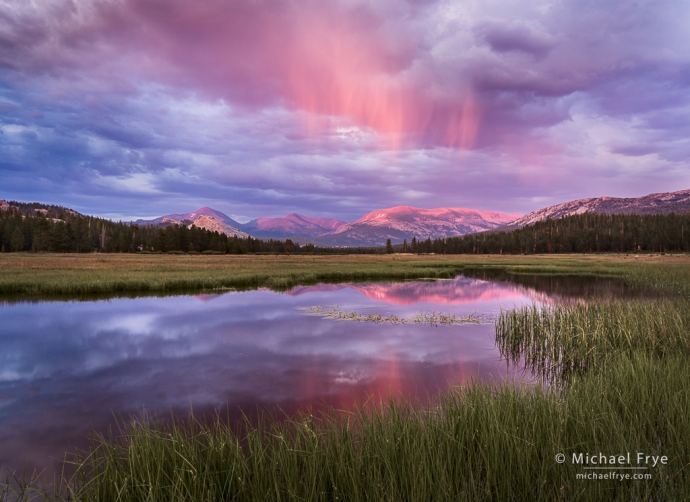
Sunset clouds, Tuolumne Meadows, Yosemite NP, California. Light from the setting sun caught some virga (rain that doesn’t reach the ground) falling from a passing thunderstorm.
I’ve been lucky to live in or near Yosemite for the last 40 years. It’s such a wonderful place. And for about five months of the year, when the Tioga Road is open, I can easily get up to the cool, uncrowded, beautiful high country. It’s always a treat to breathe the thin, pine-scented air while hiking to a secluded alpine lake, or a field of wildflowers.
Last year the Tioga Road didn’t open until July 22nd, its latest opening date ever, which limited the time we got to spend in the high country. But this year Claudia and I got to hang out up there for extended periods before, during, and after our Starry Skies and Range of Light workshops. While not at the record levels like 2023, we did have a good snowpack this year, keeping the water levels high in the creeks and rivers, and creating some nice wildflower displays. We also saw monsoonal moisture sometimes pushing up into the mountains, creating clouds, showers, and thunderstorms, which makes things exciting – and makes for interesting photographs. In other words, it was really beautiful.
John Muir called the Sierra Nevada the Range of Light. Muir wasn’t a photographer, but he was keenly observant, and I think he nailed it. I’ve long thought the light in these mountains is exceptional.
Of course light is always a key component of any photograph. Sometimes you get lucky and the weather creates something interesting, like sunbeams, rainbows, or clouds turning color at sunset. And in some of the accompanying photographs from our summer excursions into the Yosemite high country I took advantage of weather and clouds to add interesting or unusual light to a scene.
But some of these photos were made in rather “ordinary” light, like shade. While the light wasn’t exceptional, it complemented the subject, and helped tell the story I wanted to tell. And that’s all you need – for the light, subject, and composition to work together and complement each other.
Whenever I set out with my camera, I’m always thinking about the light, weather, and current conditions. What kind of light and weather am I likely to find? What are the other conditions right now, like water levels, waves along the shore, flowers blooming, autumn colors, etc.? Is there anything special or unusual?
And then I’m trying to marry the light, conditions, and possible locations together. I can’t change the weather, or the way the sun moves, or where and when flowers bloom. But I can try to find situations where the subject, light, and other conditions might work together, and give me an opportunity to make an expressive photograph. That might mean chasing some interesting, unusual, and fleeting weather, like in the photograph at the top of this post, or some of the images in my previous post about Mono Lake. Or it could mean focusing on something smaller, where the light and subject can complement each other, as in some of the photographs below.
And then, of course, you have to find a composition. Maybe the combination of light and subject has potential, but the resulting photograph won’t capture that potential unless you can arrange things in a compelling way. The light, subject, and composition need to work together to create a cohesive message.
— Michael Frye
P.S. Since light and composition are such vital components of successful photographs, I’ve created two online workshops that cover these subjects in depth. I announced new editions of these workshop yesterday, but we still have a few spots available in each: Advanced Composition and Storytelling, October 26-27, and Mastering Light, November 2-3.
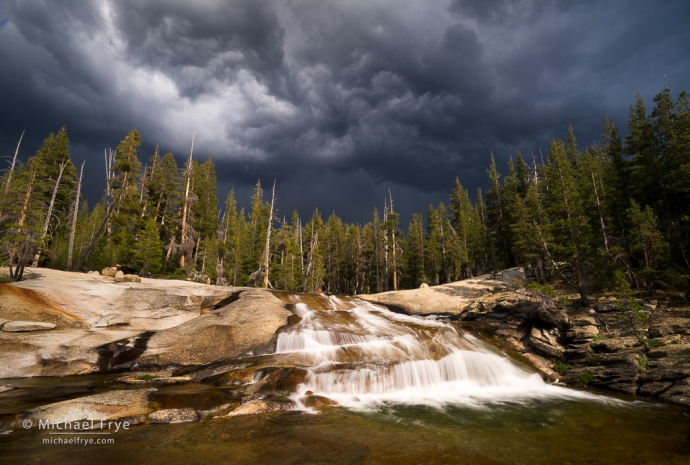
Cascade and storm clouds, Yosemite NP, California. An ominous thunderstorm darkened the skies above this cascade during our Range of Light workshop. We thought we’d get dumped on, but the storm slid by, and we only caught some light sprinkles.
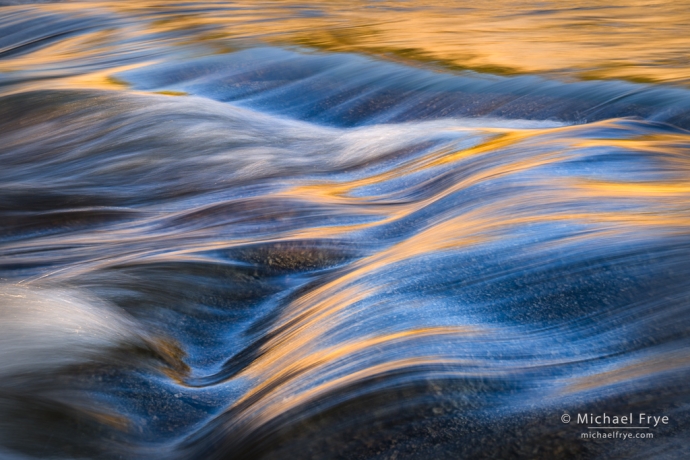
Reflections in the Tuolumne River, Yosemite NP, California. At the end of a cloudless, sunny day, we photographed the beautiful, golden colors of sunlit rocks reflected in shaded water.
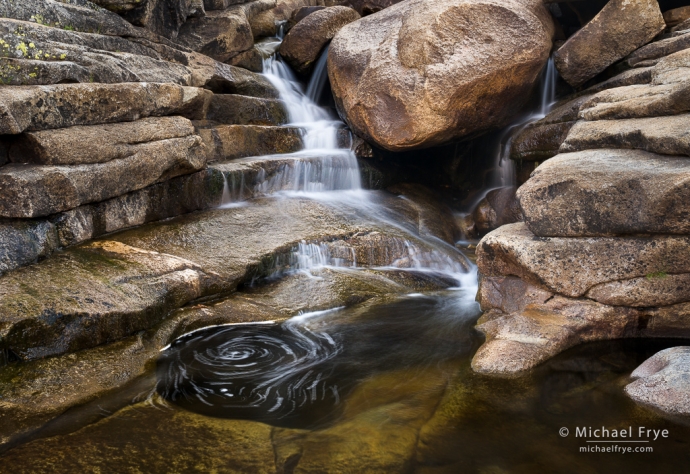
Rocks, cascade, and swirling foam, Yosemite NP, California. Shade created by soft light complemented this scene, allowing the white water and foam to stand out against darker surroundings.
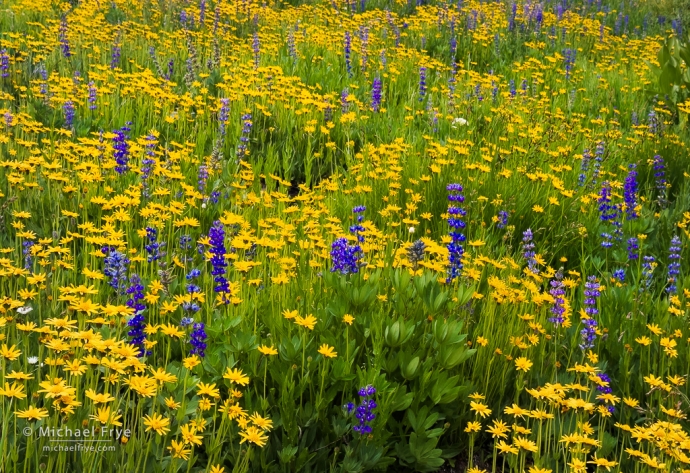
Lupines and groundsel, Yosemite NP, California. Soft shade like this is perfect for showcasing colors and color contrasts in flower photos.
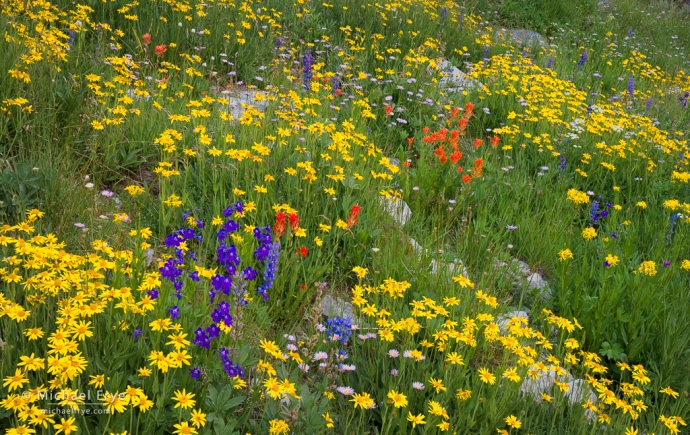
Larkspur, paintbrush, lupine, and groundsel, Yosemite NP, California. Again, soft light emphasized the colors and color contrasts in this scene.
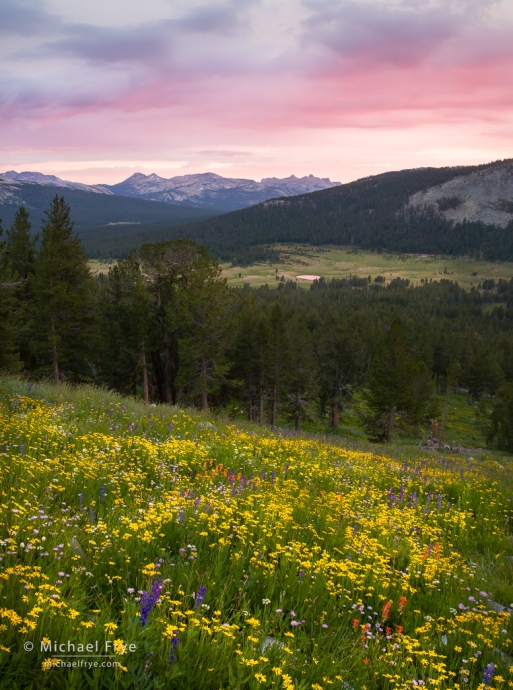
Wildflowers at sunset in the Yosemite high country, Yosemite NP, California. Most of this scene was in the shade, and that soft light worked well for the wildflowers. The sky has a touch of color, but not too much; sometimes a too-vibrant sunrise or sunset sky can compete with, rather than complement, colorful foreground subjects like flowers or autumn leaves.
Related Posts: The Light and Colors of Mono Lake; Melting Ice
Michael Frye is a professional photographer specializing in landscapes and nature. He lives near Yosemite National Park in California, but travels extensively to photograph natural landscapes in the American West and throughout the world.
Michael uses light, weather, and design to make photographs that capture the mood of the landscape, and convey the beauty, power, and mystery of nature. His work has received numerous awards, including the North American Nature Photography Association’s 2023 award for Fine Art in Nature Photography. Michael’s photographs have appeared in publications around the world, and he’s the author and/or principal photographer of several books, including Digital Landscape Photography: In the Footsteps of Ansel Adams and the Great Masters, and The Photographer’s Guide to Yosemite.
Michael loves to share his knowledge of photography through articles, books, workshops, online courses, and his blog. He’s taught over 200 workshops focused on landscape photography, night photography, digital image processing, and printing.









I so enjoy seeing your photos from Yosemite. I first discovered it for myself when I lived in Merced for three years in the late ’70s, and it’s what got me started with photography then. I went there many times while living there, and now that I live in Oregon after all these years I try to get down there as often as possible.
Thanks Ted! I’m glad you got to have that Yosemite experience those many years ago, and still like coming to Yosemite. What brought you to Merced?
Range of Light indeed!
For my eye, the water reflections on Tuolumne & the Rocks / Cascade /Swirls images are exceptional.
Michael:
Thanks for posting the article and your photos. So wonderful!
It seems that the slopes above the Meadows seem more lush than the Meadows themselves. When I was recently in Tuolumne Meadows (mid -July) it seems the wildflowers were a little past prime, and things were drying out. (Note to self: next visit to the Meadows…bring a macro lens for wildflowers and hike higher!)